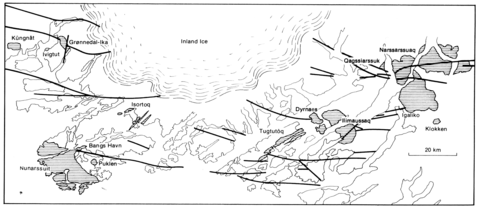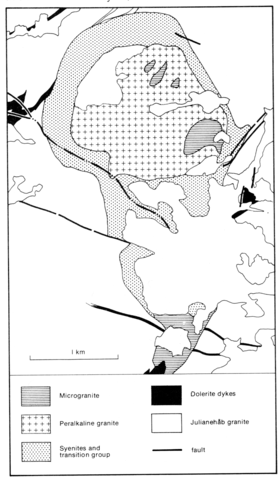stripes
At about 4x2 km Puklen is one of the smallest Gardar intrusions and lies 3 km east of the much larger but petrographically similar Nunarssuit complex (No. 34). Outer contacts are usually sharp and outward dipping but some mobilization of basement granite is evident and dolerite dykes are hornfelsed. The main part of the Puklen intrusion in the north consists of a central peralkaline granite with smaller areas of microgranite within it, surrounded by a group of augite and quartz syenites and rocks grading into granite, referred to by Parsons (1972) as a transition group; the latter contains mineral layering. Contacts between the principal rock types are variably gradational or sharp but quartz-free augite syenites are cut by veins of transition group syenites and by granite. Quartz content varies continuously from quartz-free syenites to granites and the microperthitic feldspar from orthoclase through orthoclase plus microcline to microcline alone in the granites. Pyroxenes vary from augite in the quartz-free and quartz syenites through strongly zoned aegirine-augite to aegirine in the granite. Hornblende, fayalite and opaques are important phases in the syenites and quartz syenites, but are replaced by riebeckite-arfvedsonite and a little biotite, astrophyllite and aenigmatite in the granites, indicating the increase in peralkalinity through this series. Rock analyses, modes and detailed accounts of the petrography and feldspar mineralogy are available in Parsons (1972).
PARSONS, I. 1972. Petrology of the Puklen syenite-alkali granite complex, Nunarssuit, South Greenland. Meddelelser om Gronland, 195(3); 1-73.
PULVERTAFT, T.C.R. 1961. The Puklen intrusion, Nunarssuit, SW Greenland. Meddelelser om Gronland, 123(6): 33-50.


